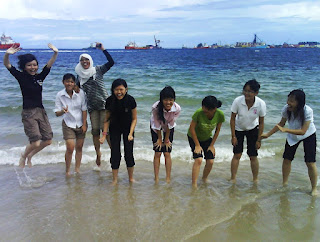Yo!! It's Wesak Day! Actually I was not a very superstitious buddhist and I didn't know much about buddhism at first. I just followed my family to the buddhist centre every 1st and 15th day of lunar calendar before. But I learnt something after the buddhist class in plkn. Although I'm not pro enough to tell others about my religion, but at least I know the origin of buddhism. Hehe...
To celebrate this festival (actually not celebrate lah), I went to the Buddhist Centre in Sibu with my family this afternoon. Fuuyooo.. Sibu people really like to appear during festivals only. Hehe... If not, the buddhist centre was normally cool and quiet. Ooops. Sorry to say that.
What we normally do during Wesak Day is 浴佛。 Here it is.
Small kid bathing the Buddha
The stage
Posing in front of Guan Yin. OMG. I'm putting on weight. Look big bah.
Well, since I've never posted articles about Buddhism, just let me have a brief introduction on my religion.
What is buddhism?
Buddhism is a religion based on the teachings of Siddhartha Gautama, who lived about 26 centuries ago in what is now Nepal and northeastern India. He came to be called "the Buddha," which means "awakened one," after he experienced a profound realization of the nature of life, death and existence. In English, the Buddha was said to be enlightened, although in Sanskrit it is bodhi, "awakened."
In the remaining years of his life, the Buddha traveled and taught. However, he didn't teach people what he had realized when he became enlightened. Instead, he taught people how to realize enlightenment for themselves. He taught that awakening comes through one's own direct experience, not through beliefs and dogmas.
In the centuries following the Buddha's life, Buddhism spread throughout Asia to become one of the dominant religions of the continent. Estimates of the number of Buddhists in the world today vary widely, in part because many Asians observe more than one religion, and in part because it is hard to know how many people are practicing Buddhism in Communist nations like China. The most common estimate is 350 million, which makes Buddhism the fourth largest of the world's religions.
Siddhartha Gautama's Early Life
Siddhartha Gautama was born about 583 BCE, in or near what is now Nepal. His father, King Suddhodana, was leader of a large clan called the Shakya. His mother, Queen Maya, died shortly after his birth.
When Prince Siddhartha was a few days old, a holy man prophesied the Prince would be either a great military conqueror or a great spiritual teacher. King Suddhodana preferred the first outcome and prepared his son accordingly. He raised the boy in great luxury and shielded him from knowledge of religion and human suffering. The Prince reached the age of 29 with little experience of the world outside the walls of his opulent palaces.
The Four Passing Sights
One day, overcome with curiosity, Prince Siddhartha asked a charioteer to take him on a series of rides through the countryside. On these journeys he was shocked by the sight of an aged man, then a sick man, and then a corpse. The stark realities of old age, disease, and death seized and sickened the Prince.
Finally, he saw a wandering ascetic. The charioteer explained that the ascetic was one who had renounced the world and sought release from fear of death and suffering.
The Renunciation
For a time the Prince returned to palace life, but he took no pleasure in it. Even the news that his wife Yasodhara had given birth to a son did not please him. The child was called Rahula, which means "fetter."
One night he wandered the palace alone. The luxuries that had once pleased him now seemed grotesque. Musicians and dancing girls had fallen asleep and were sprawled about, snoring and sputtering. Prince Siddhartha reflected on the old age, disease, and death that would overtake them all and turn their bodies to dust.
He realized then that he could no longer be content living the life of a prince. That very night he left the palace, shaved his head, and changed his prince's clothes for a beggar's robe. Then he began his quest for enlightenment.
The Search
Siddhartha began by seeking out renowned teachers, who taught him about the many religious philosophies of his day as well as how to meditate. But after he had learned all they had to teach, his doubts and questions remained. so he and five disciples left to find enlightenment by themselves.
The six companions attempted to find release from suffering through physical discipline--enduring pain, holding their breath, fasting nearly to starvation. Yet Siddhartha was still unsatisfied. It occurred to him that in renouncing pleasure he had grasped pleasure's opposite--pain and self-mortification. Now Siddhartha considered a Middle Way between those two extremes.
He remembered an experience from his childhood, when his mind had settled into a state of deep peace. The path of liberation was through discipline of mind. He realized that instead of starvation, he needed nourishment to build up his strength for the effort. But when he accepted a bowl of rice milk from a young girl, his companions assumed he had given up the quest and abandoned him.
The Enlightenment of the Buddha
Siddhartha sat beneath a sacred fig (Ficus religiosa), known ever after as the Bodhi Tree, and settled into meditation.
The work of Siddhartha's mind came to be mythologized as a great battle with
Mara, a demon whose name means "destruction' and who represents the passions that snare and delude us. Mara brought vast armies of monsters to attack Siddhartha, who sat still and untouched. Mara's most beautiful daughter tried to seduce Siddhartha, but this effort also failed.
Finally, Mara claimed the seat of enlightenment rightfully belonged to him. Mara's spiritual accomplishments were greater than Siddhartha's, the demon said. Mara's monstrous soldiers cried out together, "I am his witness!" Mara challenged Siddhartha--who will speak for you?
Then Siddhartha reached out his right hand to touch the earth, and the earth itself roared, "I bear you witness!" Mara disappeared. And as the morning star rose in the sky, Siddhartha Gautama realized enlightenment and became a Buddha.
The Teacher
At first, the Buddha was reluctant to teach, because what he had realized could not be communicated in words. Only through discipline and clarity of mind would delusions fall away and the Great Reality could be directly experienced. Listeners without that direct experience would be stuck in conceptualizations and would surely misunderstand everything he said. But compassion persuaded him to make the attempt.
After his enlightenment, he went to the Deer Park in Isipatana, located in what is now the province of Uttar Pradesh, India. There he found the five companions who had abandoned him, and to them he preached his first sermon. This sermon has been preserved as the
Dhammacakkappavattana Sutta and centers on the
Four Noble Truths. Instead of teaching doctrines about enlightenment, the Buddha chose to prescribe a path of practice through which people can realize enlightenment for themselves.
The Buddha devoted himself to teaching, attracting hundreds of followers. Eventually he became reconciled with his father, King Suddhodana. His wife, the devoted Yasodhara, became a nun and disciple. Rahula, his son, became a novice monk at the age of 7 and spent the rest of his life with his father.
Last Words
The Buddha tirelessly traveled and taught until his death at age 80. His last words to his followers:
"Behold, O monks, this is my last advice to you. All component things in the world are changeable. They are not lasting. Work hard to gain your own salvation."
Siddharta Gautama
Siddhartha has already abandoned all that he knew as a Brahmin to seek his answers as an ascetic Samana. Nothing is too great a task for him but every task seems impossible, and again it's proven, anything's possible.
Yeah, anything's possible!!!


















































